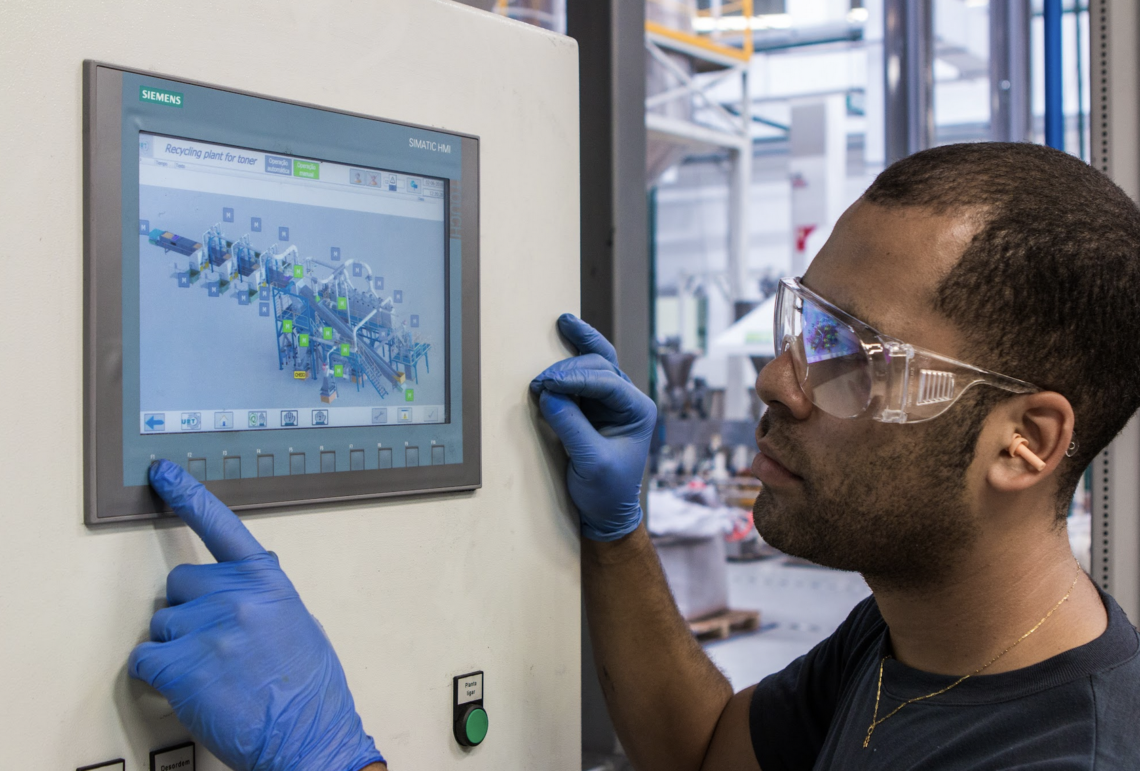As some 3,000 workers wind their way to the cafeteria each day at a factory in the Brazilian city of Sorocaba, they pass an inner courtyard that contains a small white statue of a lighthouse that serves as a symbol of the plant’s successful journey over the pastdecade to reduce its environmental footprint.
The factory, which is owned by Flex, one of the world’s largest diversified manufacturers, was amongst the first to be designated as a Sustainability Lighthouse by the World Economic Forum.
“When you walk on the factory floor at every station, every person, from the GM to the operators tells you how proud they are of what they have achieved,” says Paul Baldassari, Flex’s Executive Vice President of Global Operations.
Over 130 factories worldwide have been labeled lighthouses by the Forum but only 13 for sustainability. Each chosen lighthouse integrates Fourth Industrial Revolution technologies (4IR), from artificial intelligence and robotics to Cloud computing and Big Data to increase productivity, engage work forces and build supply chain resilience. The idea is to enable other manufacturers to become “smart followers” that benefit from what these lighthouses have already learned to be able to scale faster. The new sustainability category recognizes manufacturing enterprises that have managed to embrace both sustainability and 4IR technologies at scale.
The Sorocaba factory’s achievements include:
- Developing a circular economy ecosystem: The site’s Cloud-based reverse logistics system uses automated materials separation and IoT-enabled collection bins to transform electronic waste and reintroduce materials into the supply chain by repairing, harvesting and recycling parts and materials, resulting in a 94% reduction of material waste and a 38% reduction of plastic material costs. This reduced the need for resources equivalent to 44,000 carbon credits.
- Implementing a real time, Industrial Internet of Things-enabled digital factory performance management system connected to 44 production lines. This provides real-time data and transparency, resulting in material loss reduction by 81% and an overall equipment effectiveness increase of 23%.
- Reducing energy usage, water consumption and scope 1, 2 and 3 greenhouse gas emissions with 4IR technologies like smart utilities management and a digitized CO2 emissions dashboard.
- Implementing an advanced real time supply chain solution to accelerate product flow, creating on-demand transparency and enabling supply chain resiliency.
The Sorocaba plant’s progress is an example of how advanced technologies can help manufacturers significantly reduce their environmental footprint, says Federico Torti, the Forum’s Initiatives Lead, Advanced Manufacturing and Value Chains.
Once a factory digitizes it makes it easier to become sustainable, says Baldassari. “What you can’t measure you can’t improve. If you can create a rich database, then you can optimize not only around the carbon footprint of the products but also the whole supply chain including transportation and recycling and re-manufacturing. This has been a big learning for how we want to structure our factories in other parts of the world,” he says.
Creating A Circular Economy For Electronic Components
While other factories in the world have succeeded at making their facilities greener and more efficient by using technology to help cut water and energy use and decrease Co2 emissions, Flex’s Sorocaba facility has gone further by additionally embracing a circular economy approach. It is adding IoT devices to containers for waste collection around the city of Sao Paulo to recognize and monitor incoming waste. By doing this it enabled a reverse logistics use case for e-waste printers and other devices Flex manufactures at the Sorocabo plant, ensuring classification, collection and recycling of products that would have been otherwise become waste. The plant also uses a high percentage of recycled plastic – up to 40% in new products.
The approach requires informed conversations with customers on recyclable and reusable materials, design changes, simplifying the material composition of products to make it easier to recycle and reuse materials and changing the bill of materials for the end products, he says.
For example, the factory found a way to swap a material used in a mechanical part of a personal printer that had to be imported from abroad with materials recycled locally. Flex was able to demonstrate that the recycled product is as good or better as the virgin material used and lowered the products carbon footprint in three ways: less energy to get to the level of polycarbonates, a group of thermoplastic polymers containing carbonate groups in their chemical structures that are easily worked, molded, and thermoformed, less transportation because the recycling is done on-site in Sorocaba’s cargo facility, and by reducing the amount of material that ends up in landfills.
“You always want to know how much Co2 is used to manufacture or refurbish or recycle a product and be able to feed that back to your customer and have an educated conversation around redesign,” says Baldassari. “Once you know what your carbon footprint is in certain parts of your bill of materials then you can look at the opportunities to exchange it for something that has less impact on the environment, he says. That’s where “value engineering” comes in. “We are able to go back to our customers and show them that there is either no – or a positive – impact on the longevity of the product because you want to make sure that the product is as durable as possible to reduce the customer’s potential carbon footprint,” he says.
Sorocaba’s approach is a mix of what the factory was able to learn from some of Flex’s factories in other locations and local innovation, says Baldassari. “It’s about finding the right mix,” he says. “You build on the strong knowhow from others and then take all the different elements and rearrange and optimize them and then, in the areas where you find gaps, you innovate new processes and tools. “
Baldassari says the thing he is most proud of is that the factory has achieved “full integration of manufacturing, refurbishing and recycling to provide a sustainable solution for the customer.”
Making Workers Feel Part Of The Journey
He is also proud of how the plant’s workers have energetically embraced sustainability. “When I visited the site a few weeks ago there was no conversation where we didn’t talk about sustainability,” he says. The factory has made a point of making workers feel part of the process. “Everybody can bring an idea and they can form a small group to actually implement that idea,” says Baldassari. “If you can discuss your idea with colleagues and feel like you can make a difference it makes people feel like they are part of the journey.”
The Sorocaba factory is also trying to ensure employees are comfortable with adapting cutting –edge technologies. It has upskilled over 200 employees on developing and using low and no code digital tools and implemented Robotic Process Automation (RPA) solutions. This eliminated repetitive tasks for humans, resulting in a 38% reduction in nonvalue-added work, and an increase of both employee and customer satisfaction, according to the company.
The Brazilian factory has come a long way in the last decade, says Baldassari, but it is not done innovating. “While we achieved the milestone of becoming a sustainability lighthouse the Sorocaba plant’s journey is far from over,” he says. “I am sure that the team will continue to innovate and bring their full energy in making sure that we continuously drive sustainability.”
To assess more of The Innovator’s articles on The Future Of Manufacturing click here.
This article is content that would normally only be available to subscribers. Sign up for a four-week free trial to see what you have been missing.




